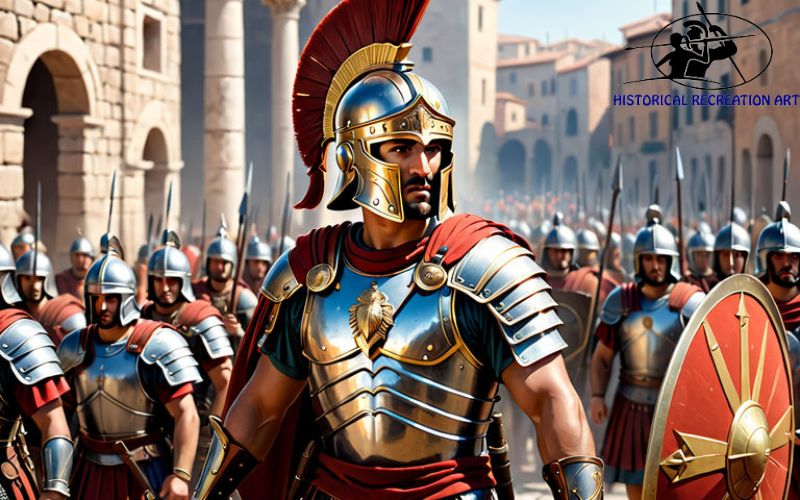Table of Contents
- Introduction
- Overview of Historical Helmets
- Relevance and Importance Today
- Historical Development
- Origins of Helmets
- Evolution Through the Ages
- Types of Historical Helmets
- Roman Helmets
- Viking Helmets
- Medieval Helmets
- Samurai Helmets
- Renaissance Helmets
- Craftsmanship and Materials
- Traditional Crafting Techniques
- Modern Manufacturing Methods
- Materials Used in Helmets
- Applications and Uses
- Historical Reenactments
- LARP and Cosplay
- Film and Theatre
- Functional Armor for Combat Sports
- Benefits of Historical Helmets
- Protection and Durability
- Historical Accuracy and Aesthetic Appeal
- Collectibility and Investment Value
- Challenges and Limitations
- Weight and Comfort Issues
- Maintenance and Care
- Buying Guide
- How to Choose the Right Historical Helmet
- Key Considerations When Purchasing
- Trusted Brands and Manufacturers
- Maintenance and Care
- Cleaning and Storage Tips
- Repairing Damaged Helmets
- Personal Stories and Case Studies
- Historical Figures and Their Helmets
- Modern Enthusiasts and Collectors
- Expert Insights
- Quotes and Advice from Historical Armor Experts
- The Future of Historical Helmet Crafting
- FAQs
- Common Questions About Historical Helmets
- Expert Answers and Tips
- Conclusion
- Summary of Key Points
- Call to Action for Further Education
Introduction
Overview of Historical Helmets
Helmets have been a crucial element of armor throughout history, providing essential protection for warriors in battle. These protective headpieces come in various shapes and styles, each reflecting the era and culture from which they originated. Historical helmets are not only functional but also serve as fascinating artifacts that offer insights into the technological advancements and artistic expressions of past civilizations.
Relevance and Importance Today
Today, historical helmets are valued for their craftsmanship and historical significance. They are used in a variety of modern contexts, including historical reenactments, LARP (Live Action Role-Playing), cosplay, film and theatre productions, and combat sports. Collectors and enthusiasts appreciate these helmets for their aesthetic appeal and the meticulous craftsmanship involved in their creation.
Historical Development
Origins of Helmets
The earliest helmets date back to ancient civilizations such as the Sumerians and Egyptians, who crafted simple headgear from leather and bronze to protect warriors in combat. As metallurgy advanced, so did the design and effectiveness of helmets.
Evolution Through the Ages
Throughout history, helmet design evolved to meet the changing demands of warfare. From the bronze helmets of the Greeks to the iron and steel helmets of the Romans and medieval knights, each era saw innovations that improved the protection and functionality of these essential pieces of armor.
Types of Historical Helmets
Roman Helmets
Roman helmets, known as galea, were typically made of bronze or iron and featured distinctive crests. They provided excellent protection for the head and neck while allowing for visibility and mobility.
Viking Helmets
Contrary to popular belief, Viking helmets did not have horns. These helmets were typically made of iron and featured a simple, rounded design that offered good protection without being overly cumbersome.
Medieval Helmets
Medieval helmets evolved significantly over the centuries. Early designs, such as the nasal helm, offered basic protection, while later designs like the great helm and bascinet provided full coverage of the head and face.
Samurai Helmets
Samurai helmets, or kabuto, were elaborately designed and often featured intricate decorations. These helmets were part of a larger armor set called yoroi, which provided comprehensive protection for the samurai warrior.
Renaissance Helmets
During the Renaissance, helmets became more ornate and were often crafted with intricate engravings and decorations. These helmets, such as the close helmet and the burgonet, combined functionality with artistic expression.
Craftsmanship and Materials
Traditional Crafting Techniques
Traditional helmet crafting involved hammering and shaping metal by hand, a labor-intensive process that required great skill. Artisans would often decorate helmets with engravings, inlays, and other artistic details.
Modern Manufacturing Methods
Today, helmets can be produced using modern techniques such as casting and stamping, which allow for greater precision and consistency. However, handmade helmets are still highly valued for their authenticity and craftsmanship.
Materials Used in Helmets
Historically, helmets were made from materials such as bronze, iron, and steel. Modern reproductions may use these materials or alternatives like aluminum and stainless steel, which offer similar appearance and durability with less weight.
Applications and Uses
Historical Reenactments
Historical reenactors use period-accurate helmets to authentically recreate battles and events from the past. These helmets provide not only protection but also an essential visual element that enhances the realism of the reenactments.
LARP and Cosplay
In LARP and cosplay, historical helmets add authenticity and visual appeal to costumes. They help bring characters to life and create an immersive experience for participants.
Film and Theatre
Helmets are frequently used in film and theatre to depict historical or fantasy characters accurately. They contribute to the visual storytelling and help create a believable setting.
Functional Armor for Combat Sports
Certain combat sports, such as HEMA (Historical European Martial Arts), utilize historical helmets for protection during practice and competition. These helmets ensure safety while allowing participants to engage in realistic combat scenarios.
Benefits of Historical Helmets
Protection and Durability
Historical helmets provide excellent protection for the head and neck, crucial areas in combat. Their durability ensures they can withstand the rigors of use in reenactments and combat sports.
Historical Accuracy and Aesthetic Appeal
Authentic reproductions of historical helmets offer a visual and tactile connection to the past. They are prized for their historical accuracy and intricate designs.
Collectibility and Investment Value
High-quality historical helmets are sought after by collectors and can appreciate in value over time. They are not only a passion for enthusiasts but also a worthwhile investment.
Challenges and Limitations
Weight and Comfort Issues
One of the main drawbacks of historical helmets is their weight, which can be uncomfortable during extended wear. Modern reproductions often use lighter materials to address this issue while maintaining historical accuracy.
Maintenance and Care
Proper maintenance is essential to prevent rust and damage. Helmets should be regularly cleaned, oiled, and stored in a dry, cool place to preserve their condition.
Buying Guide
How to Choose the Right Historical Helmet
When selecting a historical helmet, consider its intended use, the material, and the craftsmanship. Handmade pieces may be more expensive but offer greater authenticity and durability.
Key Considerations When Purchasing
Look for reputable sellers and manufacturers who provide detailed information about their products. Pay attention to the type of metal used, the historical accuracy of the design, and the overall quality.
Trusted Brands and Manufacturers
Some well-known brands and manufacturers specialize in high-quality historical helmets. Research and reviews can help you identify reliable sources for purchasing.
Maintenance and Care
Cleaning and Storage Tips
Regularly clean your helmet with mild soap and water, and thoroughly dry it to prevent rust. Store it in a dry, cool place, and use silica gel packs to absorb moisture.
Repairing Damaged Helmets
Repairing a helmet involves fixing dents, replacing damaged parts, and restoring any decorative elements. This can often be done by a professional or through DIY methods if you have the necessary skills.
Personal Stories and Case Studies
Historical Figures and Their Helmets
Historical figures such as Alexander the Great and Joan of Arc are known for their iconic helmets, which symbolize their leadership and bravery. These helmets are often replicated and celebrated for their historical significance.
Modern Enthusiasts and Collectors
Today, many enthusiasts and collectors appreciate historical helmets for their craftsmanship and historical value. Interviews and profiles of these individuals can provide insights into the community and its passion for historical armor.
Expert Insights
Quotes and Advice from Historical Armor Experts
Experts in historical armor offer valuable advice on choosing, maintaining, and appreciating historical helmets. Their insights can help both beginners and experienced enthusiasts.
The Future of Historical Helmet Crafting
Advancements in materials and manufacturing techniques continue to shape the future of historical helmet crafting. Experts predict new innovations that will make these helmets more accessible and versatile.
FAQs
Common Questions About Historical Helmets
- What is a historical helmet?
A historical helmet is a protective headgear used by warriors in various periods and cultures, known for its functionality and craftsmanship. - How do I maintain a historical helmet?
Regular cleaning, drying, and proper storage are essential to prevent rust and damage. - Are historical helmets still used today?
While not used in modern combat, historical helmets are popular in reenactments, cosplay, film, theatre, and combat sports.
Expert Answers and Tips
Experts recommend investing in high-quality historical helmets for authenticity and durability. They also suggest learning basic maintenance and repair techniques to keep your helmet in top condition.
Conclusion
Summary of Key Points
Historical helmets are fascinating artifacts that offer a glimpse into the past. Their craftsmanship, historical significance, and versatility in modern applications make them a valuable addition to any collection.
Explore more about historical helmets and their rich history by visiting reputable sources and engaging with the community of enthusiasts. Whether for re-enactments, cosplay, or personal collection, historical

